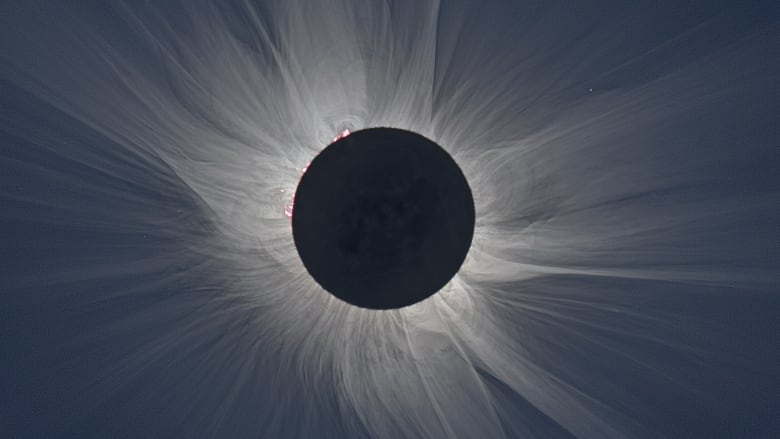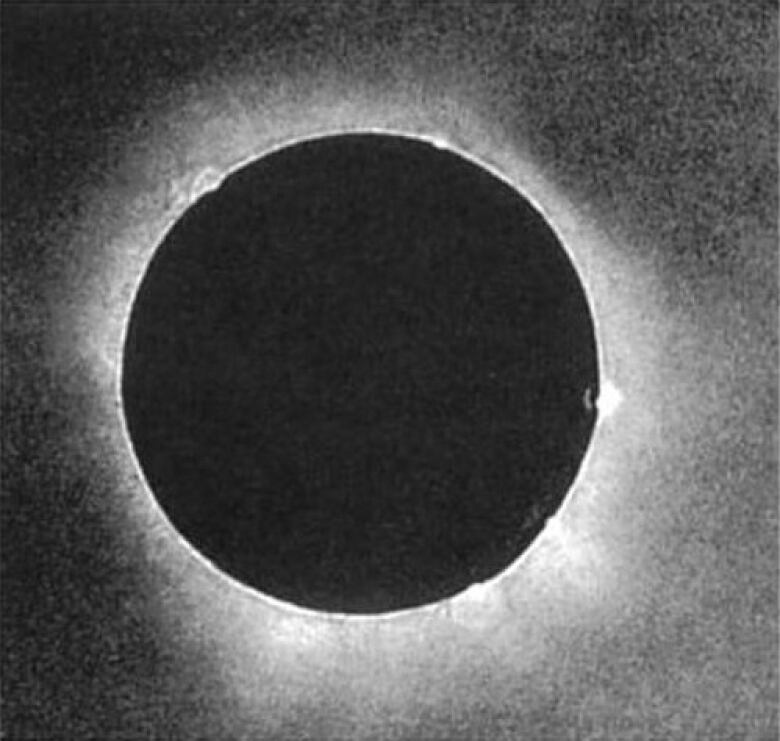How solar eclipses help us better understand our universe
The upcoming Aug. 21 eclipse will be studied across Canada and the U.S.

Total solar eclipses which occur, on average, about once every 18 months are stunning to witness: As the sun's bright light is completely put out, day turns to night, the wind dies down, andinsects, birds and other animalsbegin their evening routines.
Often, the only sounds are those of awed onlookers.
But there are those who remain hard at work during these celestial feats: scientists.
Since ancient times, solar eclipses have taught us about not only our planet, but about our solar systemand the workings of the universe as a whole.
- How and where you can watch the solar eclipse on Aug. 21
- It's worth the drive to totality: perspectives from an eclipse chaser
- How much of the total solar eclipse on Aug. 21 will you see?
It was the ancient Greeks and Romans who first really started to gain some scientific knowledge about them, noting various phenomena such as the corona the sun's outer atmosphere which appears only during a total eclipse.

Understanding the corona helps scientists better understand our nearest star, which influences Earth in multiple ways, from our weather, to our atmosphere, to the way we communicate.
A history of discovery
A history of observations during total solar eclipses has led to a better understanding of how ejectionsof particles from the sun can influence Earth. These outbursts, called coronal mass ejections, can pose a threat to astronauts, disrupt communications and satellites, and even cause power outages, as was seen in Quebec in 1989.
A solar eclipse in 1868 also led to the discovery of a new element: helium. (Though it is one of the most abundant elements in our universe, it wouldn't be found on Earth until 1895.)
How to watch CBC's eclipse coverage
On Monday, Aug. 21, the sun will be eclipsed by the moon. While the path of totality will stretch across a swath of the U.S. from Oregon to South Carolina for the first time in nearly a century, Canadian sky-watchers will be treated to a partial eclipse.
To mark this celestial show, CBC News will broadcast a live special, hosted by Hannah Thibedeau, starting at 1 p.m. ET. Watch it on CBC News Network or via live stream on CBCNews.ca. CBCNews.ca will also bring you on-the-ground coverage from sites across North America through our live blog, kicking off at 11 a.m. ET. You can also follow along on Facebook and YouTube.
And most people are at least somewhat familiar with Albert Einstein's theory of general relativity; part of that theory states that gravity can bend light. On May 29, 1919, that theory was put to its first experimental test by British physicist Arthur Eddington during a total solar eclipse.
In order to conduct the experiment, he photographed and measured the positions of various stars in the sky before and after the eclipsed sun moved into view. If Einstein was right, the stars should appear to bend ever so slightly from their normal place in the sky.
It's probably no surprise that Einstein was proven correct. Today, we are able to see a much more dramatic effect, with the bending of light from distant galaxies.

New observations
During the upcoming Aug. 21 eclipse, there will be a plethora of experiments taking place across the U.S.; NASA alone has 11 projects in the works that will study the sun.
In one study, two WB-57F jets equipped with both the DyNAMITE infrared and visible telescopes will chase the moon's shadow, flying at an altitude of 15,000 metresand up to 750 km/h. This will provide them with eight minutes of totality, more than the maximum of two minutes and forty seconds on the ground.
They plan to study not only the sun's corona, but also Mercury, which will allow them a never-before glimpse at the planet in infrared light.

Here in Canada, the National Research Council (NRC) will use the newly developed Next Generation Solar Flux Monitor to observe the sun near Penticton, B.C., which will experience about 65 per cent of the eclipse, to help scientists better understand solar activity.
"What we'll be doing is tracking the sun as the moon moves across in front, recording the signal strength in lots of different wavelengths," said Ken Tapping, an astronomer with NRC.
"And by looking at how the way signal strengthschange, we'll be able to work out what the processesare that are taking place in each of those centresas they get blocked out.
"This should teach us a lot about the physics and help us to understand a bit more about solar activity."
- Canadians, Americans prepare for total solar eclipse
- Travelling to the U.S. to watch the solar eclipse? Cellphone coverage could be spotty
Meanwhile, U.S. scientists from the National Science Foundation (NSF)and the National Center for Atmospheric Research (NCAR) will also be busy during the first total solar eclipse to span the continental U.S. in 99 years.
"This is a social phenomenon, and we have a significant opportunity to promote this and do all the science that we can," MadhulikaGuhathakurta, NASA's lead scientist for the 2017 eclipse, said in a statement.
And some universities including the University of Colorado, Boulder and Boston University plan to study the ionosphere, a region of the Earth's atmosphere where low-frequency radio waves travel. (Consider it the telecommunications superhighway, if you will.)
The upcoming eclipse will be unprecedented in terms of its scope across the United States. But it will also be unprecedented in terms of the technology available to study our star, and the data collected will likely be studied for many years to come.












_(720p).jpg)


 OFFICIAL HD MUSIC VIDEO.jpg)
.jpg)



























































































